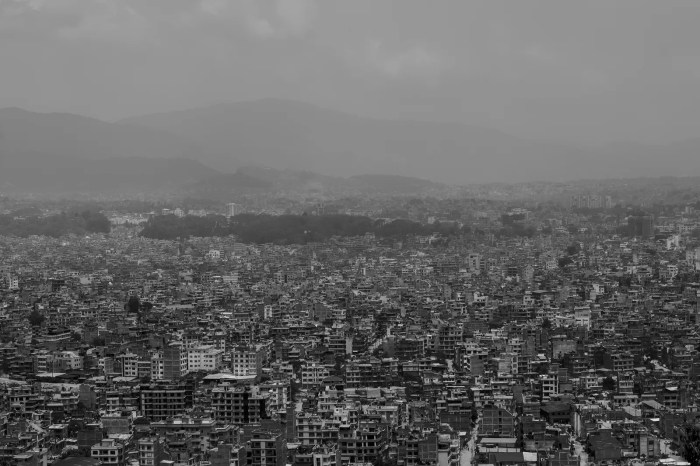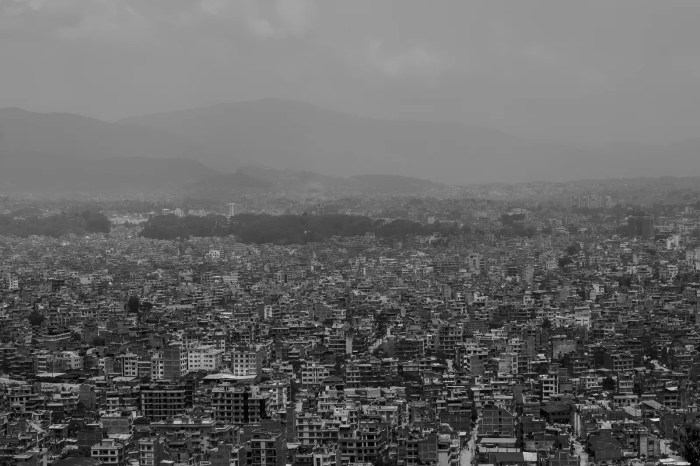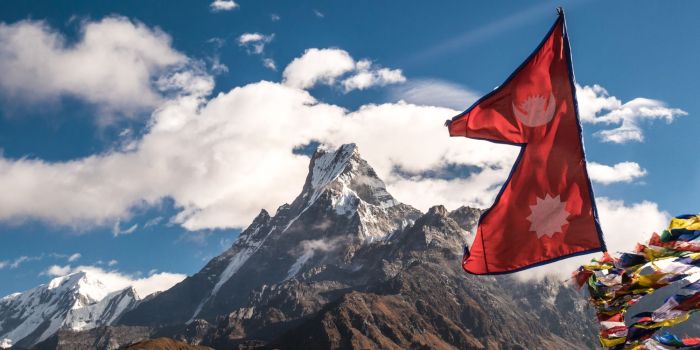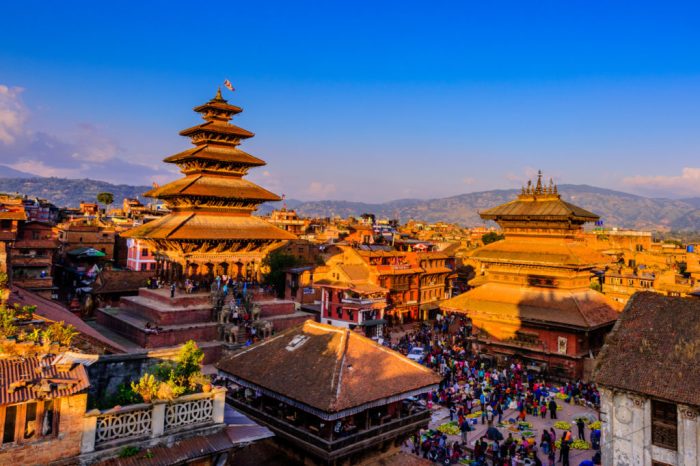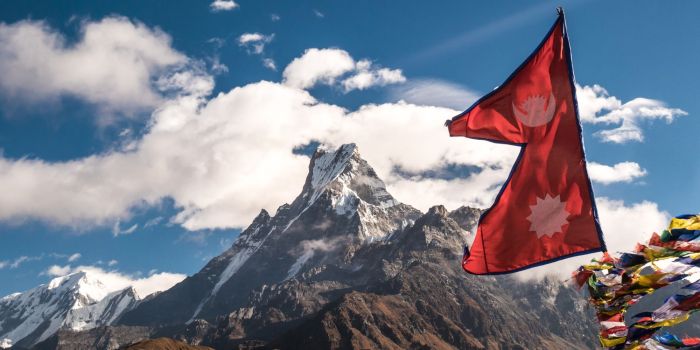Top things to do in Nepal: From breathtaking mountain views to vibrant cultural experiences, Nepal promises an unforgettable journey. This guide dives deep into the must-see landmarks, thrilling trekking routes, and immersive cultural immersion. Prepare to be captivated by the unique beauty and spirit of this Himalayan nation.
This comprehensive overview will guide you through the diverse landscapes and experiences Nepal has to offer, from the towering peaks of the Himalayas to the bustling cities. Discover the perfect blend of adventure, culture, and tranquility that awaits you in this enchanting country.
Introduction to Nepal
Nestled in the heart of the Himalayas, Nepal is a land of breathtaking landscapes, vibrant culture, and rich history. From the towering peaks of Mount Everest to the lush green valleys, Nepal offers a unique and unforgettable travel experience. This diverse nation, with its unique blend of traditions and modernity, draws visitors from around the globe, seeking adventure, spiritual enlightenment, and cultural immersion.Nepal’s geographical location, sandwiched between India and Tibet, has profoundly shaped its cultural identity and historical trajectory.
The country’s mountainous terrain, home to some of the world’s highest peaks, has influenced its architecture, lifestyle, and traditions. This rugged beauty, combined with the warmth of its people, creates a unique allure that captivates travelers.
Nepal’s Unique Culture
Nepal’s cultural tapestry is a vibrant mix of indigenous traditions and influences from neighboring regions. A significant aspect of Nepalese culture is the intricate network of festivals, each imbued with unique rituals and customs. These festivals often celebrate harvest seasons, religious events, and historical milestones. The country’s diverse ethnic groups, including the Newars, Gurungs, Magars, and Tamangs, each possess their own unique cultural heritage, traditions, and languages.
This cultural richness is reflected in Nepal’s art, music, and cuisine, which are all distinct expressions of the nation’s diverse heritage. The influence of Hinduism and Buddhism is palpable throughout Nepal’s society, evident in temples, monasteries, and everyday practices.
Nepal’s Geography and Natural Beauty
Nepal’s geography is dominated by the Himalayas, home to the world’s highest mountain, Mount Everest. This majestic mountain range, stretching across the country, creates a dramatic landscape that captivates visitors. The varied altitudes encompass diverse ecosystems, from subtropical plains to alpine meadows and high-altitude glaciers. Nepal’s diverse terrain includes lush valleys, dense forests, and cascading rivers, creating a panorama of natural beauty.
The country’s abundant wildlife, including the endangered snow leopard and the majestic one-horned rhinoceros, further enriches its natural appeal.
Nepal’s Historical Significance
Nepal’s history is intertwined with the region’s larger historical narratives. The country has been a significant player in the political and cultural landscape of South Asia for centuries. The rise and fall of various kingdoms and empires have shaped the country’s political structure and cultural identity. The country’s strategic location along ancient trade routes further highlights its historical importance.
Key Characteristics of Nepal as a Travel Destination
Nepal’s appeal as a travel destination stems from several key characteristics. The country’s stunning natural beauty, coupled with its rich cultural heritage, makes it an ideal destination for adventure seekers, nature lovers, and cultural enthusiasts. The warm hospitality of the Nepalese people creates a welcoming atmosphere, making every visitor feel at home. The relatively affordable prices for accommodations and activities compared to other destinations in the region make Nepal an accessible and attractive choice for budget-conscious travelers.
Additionally, the country’s commitment to sustainable tourism ensures that the natural and cultural heritage is preserved for future generations.
Must-See Attractions
Nepal, a land of towering mountains, vibrant culture, and ancient temples, boasts a plethora of iconic landmarks that captivate visitors. From the serene beauty of the Himalayas to the historical significance of ancient cities, each destination offers a unique experience. This section highlights five must-see attractions, exploring their cultural importance, ideal travel times, and popularity.
Iconic Landmarks of Nepal
Nepal’s rich tapestry of history and culture is woven into its stunning landscapes. The following five landmarks represent the country’s essence, drawing visitors from across the globe. Their enduring appeal stems from a blend of natural splendor and cultural significance.
Top 5 Iconic Landmarks
Nepal’s allure lies in its diverse landscapes and cultural heritage. These five destinations, each holding a unique position in Nepal’s history and culture, stand as testaments to its beauty and heritage.
| Image | Name | Description | Location |
|---|---|---|---|
| Imagine a majestic mountain peak, snow-capped and piercing the sky, framed by lush green valleys. | Mount Everest | The world’s highest mountain, Everest, stands as a symbol of Nepal’s natural grandeur. Its sheer scale and challenging ascent have captivated mountaineers and adventurers for decades. Everest holds immense spiritual significance for many Sherpa communities, who have lived in its shadow for generations. | Nepal’s Solukhumbu region, bordering Tibet. |
| Envision a vibrant city square, bustling with activity, filled with ancient temples and colorful buildings. | Bhaktapur Durbar Square | This UNESCO World Heritage Site is a testament to the rich artistic and architectural heritage of Nepal. The intricate carvings, ornate temples, and historic structures showcase the country’s artistic mastery and cultural traditions. | Bhaktapur, central Nepal. |
| Picture a serene temple complex nestled amidst the Himalayas, radiating tranquility and spirituality. | Pashupatinath Temple | This sacred Hindu temple complex, situated on the banks of the Bagmati River, is a significant pilgrimage site for Hindus worldwide. The cremation rituals performed on the banks of the river add a unique and often moving aspect to the site. | Kathmandu Valley, Nepal. |
| Contemplate a breathtaking view of the Himalayas from a vantage point high above the clouds. | Annapurna Circuit Trek | The Annapurna Circuit Trek is a renowned hiking route that winds through the Annapurna mountain range, offering breathtaking views of the Himalayas and local villages. The trek fosters a deeper understanding of the Nepali people’s way of life and their relationship with the natural world. | Central Nepal, within the Annapurna region. |
| Visualize a serene lake surrounded by lush greenery, reflecting the surrounding peaks. | Pokhara | Pokhara, nestled in the foothills of the Himalayas, is a popular tourist destination known for its natural beauty. Lakeside views, vibrant culture, and proximity to trekking routes make it a perfect base for exploring the region. | Western Nepal. |
Best Time to Visit, Top things to do in nepal
The ideal time to visit these landmarks depends largely on the specific location and desired activities. For instance, trekking in the Himalayas is best during the spring and autumn months when the weather is pleasant. Visiting cultural sites can be enjoyable year-round, although the monsoon season may affect accessibility. The best time for visiting each landmark is influenced by the specific climate conditions of that location.
Popularity Comparison
The popularity of these landmarks varies. Mount Everest, a global icon, attracts a significant number of climbers and trekkers. Cultural sites like Bhaktapur Durbar Square, with its historical significance, attract tourists interested in history and architecture. Ultimately, the popularity of each location depends on factors like accessibility, unique features, and overall appeal to tourists.
Trekking and Hiking Adventures
Nepal’s majestic mountains and diverse landscapes provide unparalleled opportunities for trekking and hiking enthusiasts. From the vibrant rhododendron forests to the snow-capped peaks, the trails offer breathtaking vistas and a chance to immerse yourself in the country’s rich culture and natural beauty. These adventures are more than just physical journeys; they are profound experiences that connect you with the heart of Nepal.The trekking routes in Nepal cater to various skill levels, from easy day hikes to challenging multi-day expeditions.
Experienced guides, porters, and local communities are readily available to assist trekkers, ensuring a safe and memorable experience. Thorough preparation and respect for the environment are key to enjoying these adventures responsibly.
Popular Trekking Routes
Nepal boasts a plethora of popular trekking routes, each offering unique landscapes and challenges. The Annapurna Circuit, encompassing the Annapurna and Dhaulagiri ranges, is one of the most popular and well-established routes. The Everest Base Camp Trek, a challenging but rewarding journey, takes trekkers close to the majestic Mount Everest. Other popular options include the Langtang Valley Trek, the Manaslu Circuit, and the Mustang Trek.
Difficulty Levels of Routes
The difficulty levels of trekking routes vary significantly. The Annapurna Circuit, for instance, generally involves moderate to challenging terrain, with some sections requiring steep ascents and descents. The Everest Base Camp Trek, on the other hand, is a more demanding expedition, requiring considerable physical endurance and acclimatization to high altitudes. The Langtang Valley Trek offers a more accessible route, while the Mustang Trek presents a unique challenge with its remote location and cultural immersion.
Necessary Gear and Preparation
Proper gear and preparation are crucial for a successful trekking experience. Essential items include sturdy hiking boots, layers of clothing suitable for varying weather conditions, a waterproof backpack, a compass and map, sunscreen, sunglasses, and a hat. It’s also vital to pack sufficient food and water, and to be prepared for potential altitude sickness. Pre-trip consultations with experienced trekking agencies and guides are strongly recommended for personalized advice.
Wildlife and Scenery
Trekking in Nepal offers a chance to encounter a diverse range of wildlife. From the elusive snow leopards to the friendly musk deer, the region is home to a rich tapestry of fauna. The stunning scenery varies from lush rhododendron forests to high-altitude glaciers, offering breathtaking vistas and opportunities for photography. The diverse flora and fauna, coupled with the spectacular mountain ranges, make for an unforgettable experience.
Trekking Packages for Tourists
Several trekking packages cater to different budgets and interests. These packages typically include accommodation, transportation, meals, and guides. For instance, the Annapurna Circuit Trek packages vary in duration, ranging from 10 to 21 days, accommodating different levels of experience and time constraints. Similarly, Everest Base Camp Trek packages are designed to accommodate the varying demands of the journey.
The packages generally include transportation to and from the starting point, accommodation along the route, meals, and experienced guides.
| Trekking Route | Difficulty | Duration (approx.) | Highlights |
|---|---|---|---|
| Annapurna Circuit | Moderate to Challenging | 10-21 days | Stunning mountain views, diverse landscapes, cultural immersion |
| Everest Base Camp | Challenging | 10-14 days | Close encounter with Mount Everest, high-altitude trekking experience |
| Langtang Valley | Moderate | 5-7 days | Beautiful valley, rhododendron forests, less crowded |
Cultural Experiences
Nepal, a tapestry woven with ancient traditions and vibrant festivals, offers a unique window into the hearts and minds of its people. Beyond the majestic mountains and thrilling treks, the country pulsates with a rich cultural heritage that’s deeply ingrained in daily life. From the intricate artistry of its crafts to the soulful melodies of its music, Nepal’s cultural expressions paint a vivid portrait of its unique identity.Immerse yourself in the warmth of Nepali hospitality and the profound respect for tradition.
Experience the profound sense of community that binds Nepalese society together, and discover the stories whispered through generations. The festivals, cuisine, and artistic traditions are more than just celebrations; they are the living embodiment of Nepal’s soul.
Nepali Festivals and Celebrations
Nepali festivals are vibrant expressions of the country’s diverse culture and spiritual beliefs. They mark significant agricultural cycles, religious events, and social milestones. These celebrations offer a glimpse into the rich tapestry of traditions and customs. The festive spirit is infectious, filling the air with music, dance, and joyful merriment.
- Dashain: The most significant festival, celebrated with immense enthusiasm and grandeur. Families gather, exchanging gifts, and participating in elaborate rituals. It marks the victory of good over evil and is celebrated over a period of 15 days.
- Tihar: A five-day festival dedicated to lights, animals, and the goddess Laxmi. Celebrated with the lighting of lamps, colourful decorations, and the worship of animals, especially cows and dogs. It symbolizes the triumph of light over darkness.
- Buddha Jayanti: Celebrated across the country, this festival marks the birth of Lord Buddha, with prayers, chanting, and processions.
Nepali Cuisine and Food Experiences
Nepali cuisine is a delightful fusion of flavours, influenced by the country’s diverse geography and cultural interactions. The dishes often feature a balance of spices, herbs, and vegetables, reflecting the rich biodiversity of the region.
- Dal Bhat Tarkari: A staple dish consisting of lentil soup (dal), steamed rice (bhat), and a vegetable curry (tarkari). It embodies the essence of Nepali culinary traditions, showcasing the country’s commitment to simple, wholesome, and flavourful meals.
- Momos: Steamed or pan-fried dumplings are a popular street food and restaurant item. These delicious treats come in various flavours, often filled with meat or vegetables.
- Thukpa: A hearty noodle soup, frequently consumed as a warm meal, especially in the mountainous regions.
Nepali Arts, Crafts, and Music
Nepal’s rich artistic heritage is evident in its intricate wood carvings, colourful paintings, and exquisite metalwork. The craftsmanship is often passed down through generations, preserving traditional techniques and aesthetics. Music plays a vital role in Nepali culture, accompanying festivals, ceremonies, and everyday life.
- Thangka Paintings: These vibrant Buddhist paintings are meticulously crafted using vibrant colours and intricate details. They depict religious figures, scenes, and narratives, often embodying profound spiritual meaning.
- Wood Carvings: The intricate wood carvings are often found on temples and homes, showcasing a mastery of design and detail. These pieces are not only beautiful but also hold significant cultural and historical value.
- Nepali Folk Music: Traditional music is closely tied to festivals and celebrations. It often uses instruments like the Madal (a double sided drum), flute, and others, weaving narratives and emotions into the music.
Nepali Hospitality and Traditions
Nepali hospitality is renowned for its warmth and generosity. Guests are treated with respect and care, reflecting a deep-rooted tradition of welcoming strangers and fostering connections. The respect for elders and community bonds are significant aspects of Nepali culture.
| Cultural Event | Dates | Location | Description |
|---|---|---|---|
| Dashain | Mid-September to Mid-October | Across Nepal | Major festival celebrating the victory of good over evil, involving rituals, feasting, and gift-giving. |
| Tihar | Late October to Early November | Across Nepal | Five-day festival of lights, featuring worship of animals, diyas (lamps), and joyous celebrations. |
| Buddha Jayanti | Around April/May | Across Nepal | Celebrates the birth of Lord Buddha, involving prayers, chanting, and processions. |
City Exploration: Top Things To Do In Nepal
Nepal’s urban centers offer a fascinating blend of ancient traditions and modern life. From the bustling markets to the historic temples, these cities provide a unique window into the country’s rich heritage and vibrant culture. Exploring Nepal’s cities allows travelers to experience a different side of the country beyond the mountains and trekking trails.Delving into the major cities unveils the intricate tapestry of Nepalese life.
These urban hubs, each with its distinct character, provide a platform to interact with local communities, sample delicious cuisine, and immerse oneself in the country’s vibrant energy. Understanding the city’s history and culture, coupled with knowledge of transportation and shopping options, enhances the overall travel experience.
Major Cities and Their Attractions
Nepal boasts several significant cities, each with its own unique appeal. Kathmandu, the capital, is a historical and cultural hub, while Pokhara, nestled in the foothills, is a popular tourist destination renowned for its natural beauty. Bhaktapur and Lalitpur (Bhadgaon), ancient cities with rich cultural heritage, provide glimpses into Nepal’s past. These cities offer distinct experiences, from the bustling markets of Kathmandu to the serene lakeside scenery of Pokhara.
Historical and Cultural Significance
Kathmandu Valley, encompassing Kathmandu, Bhaktapur, and Lalitpur, holds immense historical and cultural significance. The three cities are interconnected by a shared past and numerous historical sites. Temples, palaces, and ancient monuments scattered throughout the cities showcase centuries of artistic and architectural evolution. These sites provide a glimpse into the region’s rich past and the cultural traditions that continue to thrive today.
Bhaktapur’s Durbar Square, for instance, is a testament to the city’s historical grandeur and architectural prowess.
Transportation Options
Within the cities, transportation options range from traditional rickshaws and local buses to modern taxis and ride-sharing services. Kathmandu, as the largest city, boasts a more developed network of public transport, making it easier to navigate. Smaller cities like Bhaktapur and Lalitpur rely more on local buses and walking. Choosing the appropriate transportation method depends on the distance, budget, and personal preference.
Shopping Experiences
The shopping experiences vary considerably between the cities. Kathmandu’s Thamel area is a hub for tourists, offering a wide range of souvenirs, handicrafts, and trekking gear. Bhaktapur and Lalitpur, however, showcase local crafts and traditional products, providing a more authentic and culturally immersive shopping experience. The range of goods available and the pricing structure differ based on the city and the specific market.
Comparison of Major Cities
| City | Key Attractions | Culture | Activities |
|---|---|---|---|
| Kathmandu | Durbar Square, Pashupatinath Temple, Boudhanath Stupa, Swayambhunath Stupa | A blend of ancient traditions and modern influences; bustling markets and vibrant street life. | Temple visits, exploring markets, trying local cuisine, shopping for souvenirs. |
| Pokhara | Phewa Lake, Sarangkot viewpoint, Davis Falls, Gupteshwor Mahadev Cave | A more relaxed atmosphere with a strong focus on nature and tourism. | Boat rides, scenic walks, hiking, enjoying the lake views. |
| Bhaktapur | Bhaktapur Durbar Square, Nyatapola Temple, Pottery Square | Preserves traditional Newari culture; known for its intricate craftsmanship. | Exploring the historical monuments, interacting with local artisans, experiencing the unique culture. |
| Lalitpur (Bhadgaon) | Lalitpur Durbar Square, Krishna Mandir, Kumari Ghar | Preserves traditional Newari culture; known for its intricate craftsmanship. | Exploring the historical monuments, interacting with local artisans, experiencing the unique culture. |
Adventure Activities
Nepal, a land of breathtaking landscapes, offers a thrilling array of adventure activities for thrill-seekers and nature enthusiasts. From challenging treks through lush forests to adrenaline-pumping whitewater rafting, the opportunities are vast. This section explores various adventure activities available in Nepal, highlighting safety precautions, experience levels, and necessary equipment.
Whitewater Rafting
Whitewater rafting in Nepal is an exhilarating experience, with rivers like the Trishuli and the Seti offering varying levels of rapids. Participants navigate through the swift currents, enjoying the scenic beauty of the surrounding valleys. The intensity of the rapids varies, with some sections offering calmer stretches for novices and others challenging experienced rafters.
Nepal offers breathtaking experiences, from trekking in the Himalayas to exploring ancient temples. But beyond the famous peaks, hidden gems like Margaret River, Australia, also await discovery. If you’re looking to uncover Margaret River’s many charms, check out where to uncover margaret rivers many charms for insider tips on the best spots. Ultimately, Nepal still holds a special place for adventurous travellers seeking a unique journey.
Safety Precautions:
Before embarking on a whitewater rafting trip, participants should ensure they are physically fit and have appropriate training. Experienced guides are crucial for providing safety instructions and navigating the rapids safely. Wearing a life vest is mandatory, and following the guide’s instructions is paramount. Always be aware of your surroundings and the current conditions.
Experience Levels:
Rafting trips cater to varying experience levels. Beginners can choose calmer sections, while experienced rafters can opt for more challenging rapids. The guide will assess the participant’s experience and assign them to appropriate rapids.
Equipment:
Essential equipment for whitewater rafting includes a life vest, helmet, and appropriate clothing suitable for the weather conditions. Participants should bring comfortable, water-resistant footwear.
Mountain Biking
Nepal’s diverse terrain offers exceptional opportunities for mountain biking. From scenic trails winding through lush valleys to challenging climbs, the options are plentiful. The trails vary greatly in difficulty, catering to different experience levels.
Safety Precautions:
Mountain biking requires caution. Participants should wear appropriate protective gear, including helmets and sturdy biking attire. Following trail markers and being aware of the surrounding environment are crucial for safety. Biking in groups and informing someone of your route is highly recommended.
Experience Levels:
Mountain biking trails range from gentle slopes to steep climbs and descents. Beginners can choose less challenging trails, while experienced bikers can opt for more technical routes. The level of difficulty is typically determined by the trail’s elevation gain and the terrain’s technical aspects.
Equipment:
Essential equipment includes a mountain bike, helmet, and appropriate clothing. Proper hydration and snacks are crucial for endurance.
Rock Climbing
Nepal’s towering mountains provide challenging rock climbing opportunities for experienced climbers. The varied rock formations and technical climbs offer a unique experience.
Safety Precautions:
Rock climbing is a high-risk activity. Participants should have extensive climbing experience and be equipped with appropriate safety gear. Climbing with a certified guide is essential, and rigorous safety checks are vital before every climb.
Experience Levels:
Climbing routes cater to different experience levels. Beginners can opt for easier routes, while experienced climbers can tackle more challenging ascents. Experience with ropes, anchors, and various climbing techniques is necessary for tackling higher-difficulty climbs.
Equipment:
Climbing gear is essential, including ropes, harnesses, helmets, and carabiners. Experienced climbers will bring specialized climbing shoes. Appropriate clothing suitable for the weather conditions and elevation is crucial.
Table of Adventure Activities
| Activity | Description | Locations | Necessary Gear |
|---|---|---|---|
| Whitewater Rafting | Navigating rivers through rapids | Trishuli, Seti Rivers | Life vest, helmet, appropriate clothing |
| Mountain Biking | Exploring trails on a mountain bike | Various scenic locations | Mountain bike, helmet, appropriate clothing |
| Rock Climbing | Ascending rock faces using ropes and equipment | Himalayan mountains | Ropes, harnesses, helmets, carabiners |
Accommodation Options
Nepal offers a diverse range of accommodation options to suit every budget and preference, from cozy guesthouses to luxurious hotels. Whether you’re seeking a budget-friendly stay or a lavish experience, Nepal has something for everyone. The choice depends on your travel style, the region you’re visiting, and your desired level of comfort and service.Nepal’s accommodation landscape reflects its rich cultural tapestry, blending traditional hospitality with modern amenities.
This variety allows tourists to immerse themselves in the local environment while enjoying the comforts of their chosen lodging. The options available vary significantly depending on the destination and the time of year, with peak seasons often experiencing higher prices and limited availability.
Budget-Friendly Accommodation
Budget-friendly guesthouses and homestays are a great way to experience the local culture and save money. These establishments often provide basic amenities like clean rooms, private or shared bathrooms, and sometimes even breakfast. They are often located in or near popular tourist areas, providing easy access to attractions. The atmosphere is typically warm and welcoming, offering an opportunity to interact with locals and gain valuable insights into their lives.
- Guesthouses: These establishments are typically smaller and family-run, offering a more intimate and personal experience. They are often found in popular trekking routes and towns, providing a convenient base for exploring the surrounding areas. Expect basic amenities, such as shared bathrooms and common areas. Examples include “Sunrise Guesthouse” and “Himalayan Guesthouse” in Pokhara, known for their affordable rates and good location near lakeside attractions.
These guesthouses frequently offer breakfast and other basic services.
- Homestays: This is a unique way to immerse yourself in Nepali culture. You stay with a local family, experiencing their daily life firsthand. Meals are often prepared with fresh, local ingredients, and you’ll gain a deeper understanding of Nepali traditions and customs. Expect basic amenities, possibly shared bathrooms and simple rooms. Homestays are particularly popular in rural areas, offering a chance to experience life outside the tourist hotspots.
Luxury Accommodation
For a more luxurious experience, Nepal offers high-end hotels and resorts, featuring premium amenities and services. These establishments often boast stunning views, excellent dining options, and exceptional service. These luxurious accommodations are ideal for those seeking a more lavish and comfortable experience, often found in major cities and resort areas.
- Hotels: Hotels, particularly in Kathmandu and Pokhara, provide a range of facilities, from luxurious rooms with balconies offering breathtaking mountain views to fine dining options. These hotels are generally well-equipped, with facilities like swimming pools, spas, and business centers. Some notable hotels in Kathmandu include “Hotel Yak & Yeti” and “The Everest Hotel,” known for their upscale amenities and service.
Nepal offers incredible trekking and stunning views, but for a different kind of adventure, consider exploring the rejuvenating wellness retreats in the Mojave Desert, like the Mojave Desert skin shield wellness in Joshua Tree, California. While you’re there, experiencing the unique desert landscapes and holistic treatments, you can plan your next Himalayan trek. Nepal’s diverse landscapes, from the Himalayas to the Terai, promise a truly unforgettable experience.
- Resorts: Resorts, often found in mountain regions or near lakes, provide a tranquil escape. They offer a variety of activities, including spa treatments, hiking, and other outdoor adventures. These resorts typically feature stunning landscapes and are a perfect option for those seeking a luxurious getaway, while enjoying breathtaking natural beauty.
Comparison of Accommodation Types
| Feature | Budget-Friendly | Luxury |
|---|---|---|
| Price | Low | High |
| Amenities | Basic | Extensive |
| Service | Friendly, basic | Exceptional, personalized |
| Location | Often near attractions | Often in prime locations, with views |
These tables highlight the key differences between budget-friendly and luxury accommodation options, allowing travelers to choose based on their preferences and budget.
Examples of Hotels and Guesthouses
- Hotel Yak & Yeti (Kathmandu): A popular luxury hotel known for its excellent service and facilities. (Rating: 4.5 stars)
- The Everest Hotel (Kathmandu): Another upscale hotel with a reputation for providing a luxurious stay. (Rating: 4.3 stars)
- Sunrise Guesthouse (Pokhara): A well-regarded budget-friendly guesthouse located near lakeside attractions. (Rating: 4.0 stars)
- Himalayan Guesthouse (Pokhara): Another popular budget guesthouse in a great location. (Rating: 3.8 stars)
Food and Drink
Nepal’s culinary scene is a vibrant tapestry woven from diverse regional influences, reflecting the country’s rich cultural heritage. The food, often featuring fresh, locally sourced ingredients, offers a unique and flavorful experience for any visitor. From the hearty stews of the mountains to the delicate spices of the plains, Nepali cuisine is a delicious journey through the nation’s varied landscapes.Nepali food is deeply rooted in the traditions of its people.
The flavors are often a blend of spice, tang, and earthiness, with a focus on fresh vegetables, lentils, and grains. This emphasis on natural ingredients is complemented by the use of locally sourced spices, creating dishes that are both healthy and flavorful.
Unique Flavors of Nepali Cuisine
Nepali cuisine is known for its use of a wide array of spices and herbs, often combined in unique and unexpected ways. The flavors are often a blend of subtle sweetness, tangy sourness, and a robust heat, reflecting the diverse influences that have shaped Nepali culture over centuries. The use of spices like ginger, garlic, turmeric, and chilies adds depth and complexity to many dishes.
Common Ingredients Used in Nepali Dishes
Rice, lentils, and vegetables are fundamental to most Nepali dishes. A significant portion of the diet consists of locally grown produce, including potatoes, spinach, cauliflower, and various types of beans. Meat, though sometimes featured, is not as prevalent as vegetarian dishes in many parts of the country. The use of spices, like cumin, coriander, and fenugreek, along with herbs like cilantro and mint, is prevalent across the nation.
Regional Variations in Nepali Food
The diverse geography of Nepal gives rise to significant regional variations in its culinary traditions. The mountainous regions, for example, often feature hearty stews and soups, while the Terai region, closer to the Indian border, showcases dishes influenced by Indian cuisine, with a focus on rice and spices. Similarly, the central hills have a unique style of cooking, emphasizing vegetables and lentils.
The different altitudes and climates have also led to unique ways of preparing food, using ingredients specific to the region.
Best Places to Try Local Nepali Dishes
Several locations throughout Nepal offer authentic Nepali dining experiences. For a truly immersive experience, try local restaurants in Kathmandu Valley, Pokhara, or even in the towns along trekking routes. These local eateries often showcase regional specialties, allowing visitors to sample dishes specific to the area. You’ll find that the quality of ingredients is often directly linked to the freshness and authenticity of the food, so venturing out from tourist hotspots is a rewarding experience.
Nepali Dishes, Ingredients, Descriptions, and Origins
| Dish | Ingredients | Description | Origin |
|---|---|---|---|
| Dal Bhat Tarkari | Rice, lentils, vegetables | A staple Nepali meal consisting of steamed rice, lentil soup, and a vegetable curry. | Across Nepal |
| Momos | Wheat flour dough, vegetables, meat (optional) | Steamed or pan-fried dumplings, often filled with savory ingredients. | Tibetan/Nepali border areas |
| Thukpa | Noodles, broth, vegetables, meat (optional) | A hearty noodle soup, typically made with yak meat or vegetables, depending on the region. | Tibetan/Himalayan regions |
| Chowmein | Noodles, vegetables, meat (optional) | A stir-fried noodle dish, often with Chinese-influenced flavors. | Kathmandu Valley |
Practical Information
Planning a trip to Nepal requires careful consideration of practicalities. From visa procedures to health precautions, understanding these details will ensure a smooth and enjoyable journey. Navigating the local customs and requirements will contribute to a richer cultural experience.
Visa Requirements
Nepal offers various visa options for tourists, depending on nationality and duration of stay. Most nationalities can obtain a tourist visa on arrival at the airport or designated border crossings. This visa typically allows a stay of 30 days. However, some nationalities might require pre-approval or an e-Visa. It’s crucial to check the specific requirements for your nationality on the official Nepal government website or embassy before your trip to avoid delays or complications.
Currency Exchange Rates and Local Currency
The Nepalese Rupee (NPR) is the official currency. Exchange rates fluctuate, and it’s recommended to exchange currency at authorized exchange bureaus or banks in Kathmandu and major tourist areas for the best rates. Be aware that ATMs are available in many locations, but it’s always wise to have some local currency on hand, especially in smaller towns or villages.
Carry a mix of small and larger denominations for easier transactions.
Necessary Vaccinations and Health Precautions
Nepal’s altitude and varied climates can present health challenges. Consult your doctor about recommended vaccinations and necessary precautions. Malaria risk exists in certain regions, so consult your doctor about appropriate preventive measures. Ensure you have adequate travel insurance to cover any medical emergencies. Pack light clothing, appropriate for both warm and cool climates.
Carry a basic first-aid kit with essential medications.
Nepal’s stunning landscapes and vibrant culture are top-notch travel destinations, but safety is key. Before you trek through the Himalayas, checking out some Amazon personal safety devices for paranoid travelers like amazon personal safety devices paranoid traveler picks could give you peace of mind. Ultimately, exploring Nepal’s hidden gems while feeling secure is the best way to truly enjoy this incredible country.
Best Ways to Communicate with Locals
Learning a few basic Nepali phrases will greatly enhance your interactions with locals. A polite “Namaste” (hello/goodbye) and “Dhanyabaad” (thank you) will be appreciated. English is spoken in tourist areas, but knowing some Nepali will allow you to connect with locals on a deeper level. Use gestures and smiles to supplement your verbal communication, especially in rural areas.
Practical Information Summary
| Visa Requirements | Currency | Vaccination Advice | Local Communication |
|---|---|---|---|
| Check Nepal government website for specific requirements based on nationality. Most can get a tourist visa on arrival (30 days). | Nepalese Rupee (NPR). Exchange at authorized bureaus or banks. Use ATMs for convenience. | Consult your doctor for recommended vaccinations and health precautions, considering altitude and potential malaria risk in certain areas. Travel insurance is crucial. | Learn basic Nepali phrases like “Namaste” and “Dhanyabaad”. English is spoken in tourist areas. Gestures and smiles are helpful. |
Tips for Planning a Trip

Nepal, a land of breathtaking mountains, vibrant culture, and serene landscapes, beckons travelers from around the world. Planning a trip to this captivating Himalayan nation requires careful consideration of several factors to ensure a memorable and enjoyable experience. From choosing the optimal time to visit to navigating local customs, this section offers practical advice for a smooth and enriching journey.
Best Time to Visit, Top things to do in nepal
Nepal’s diverse climate and geographical features dictate the ideal time for a visit. Spring (March to May) and autumn (September to November) are generally considered the best seasons for trekking and sightseeing. During these periods, the weather is pleasant, the skies are clear, and the crowds are relatively manageable. Summer (June to August) is monsoon season, characterized by heavy rainfall and potential for landslides, making some trekking routes inaccessible.
Winter (December to February) brings cold temperatures and snowfall, particularly in higher altitudes, potentially impacting accessibility and activities. Consider your preferred activities and altitude tolerance when choosing the best time for your trip.
Budgeting for Your Nepal Trip
Budgeting for a Nepal trip involves considering various expenses, from flights and accommodation to food and activities. The cost of your trip will depend heavily on your travel style and the duration of your stay. Luxury hotels and upscale dining options will obviously inflate your expenses. Conversely, budget-friendly guesthouses and local eateries offer a more economical way to experience the local culture.
Factor in transportation costs, entry fees to attractions, and potential unforeseen expenses, such as medical emergencies or unexpected delays.
Transportation Options
Nepal offers a variety of transportation options, from domestic flights to buses and even treks. Domestic flights are often the fastest way to travel between major cities like Kathmandu and Pokhara. Buses are a more affordable alternative, but travel times can be significantly longer. For trekking, you’ll often need to rely on porters and local guides, and sometimes your own walking.
The choice of transportation will depend on your budget, time constraints, and the specific destinations you wish to visit. Consider the practicality of each mode of transport before making a decision. For example, a long-distance trek might be a great way to experience the Himalayas, but it requires significant time commitment and physical preparation.
Respectful Interactions with Locals
Nepal is a culturally rich nation, and respecting local customs and traditions is essential for a positive travel experience. Dress modestly when visiting religious sites. Be mindful of local etiquette, such as removing your shoes before entering homes or temples. Engage with locals with respect and courtesy, and be prepared to learn a few basic Nepali phrases.
Showing genuine interest in their culture and traditions will be greatly appreciated. Engage in meaningful conversations with the locals to gain insights into their perspectives and to develop a deeper understanding of their lives.
Step-by-Step Guide to Planning a Trip
- Define your travel style and budget: Determine if you prefer a luxury, budget, or mid-range trip. This will significantly impact your choices for accommodation, transportation, and activities. For example, budget travelers may choose to stay in guesthouses while those seeking luxury might opt for five-star hotels.
- Choose your travel dates: Consider the best time to visit Nepal based on your preferred activities and the weather conditions. This is crucial to maximize your enjoyment and minimize any potential disruptions.
- Book flights and accommodation: Reserve your flights and accommodation in advance, especially during peak seasons, to secure the best rates and availability. Consider your desired locations and the cost of flights and accommodation to ensure you stay within your budget.
- Plan your itinerary: Artikel your desired destinations, activities, and the duration of your stay at each location. Include activities like trekking, sightseeing, cultural experiences, and city explorations.
- Obtain necessary travel documents: Ensure you have the required visas and travel insurance to facilitate a smooth entry and stay in Nepal. Check visa requirements well in advance.
- Pack appropriately: Pack clothing and gear suitable for the activities you plan to undertake, considering the weather conditions. Pack light, durable, and comfortable clothing. For example, if you’re planning to hike, you’ll need sturdy hiking boots and appropriate layers of clothing.
- Inform someone about your travel plans: Informing someone about your itinerary and expected return date provides a safety net.
Ending Remarks
In conclusion, Nepal offers a remarkable tapestry of experiences for every traveler. Whether you’re an adventurous trekker, a curious cultural explorer, or a seasoned city-slicker, Nepal has something to ignite your passion. From the awe-inspiring Himalayas to the warm embrace of Nepali hospitality, this journey promises to be a transformative adventure. Plan your trip today and embark on a Himalayan expedition that will stay with you forever.

